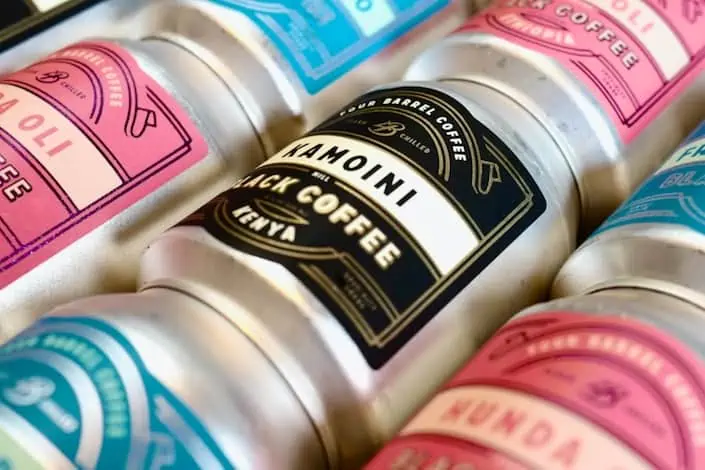
Four Barrel Coffee canned ready-to-drink black coffees. Photo courtesy of Four Barrel Coffee.
It was only two years ago that Coffee Review last explored the landscape of cold black coffees offered in ready-to-drink (RTD) format. In the 2018 report, we celebrated some excellent samples, but the majority of the submissions were produced from blends of various anonymous green coffees, as opposed to single-origin coffees from identifiable farms, mills or cooperatives, the kinds of coffees that, on average, offer more refined and individualized sensory experiences than blends.
Editor Kenneth Davids’ takeaway for the 2018 report was that “Cold brewing generally produces a somewhat different beverage than hot brewing does. The long, slow extraction tends to encourage a cup that is delicate and lightly syrupy in mouthfeel with a softer structure than produced by conventional hot brewing. Both acidity and bitterness tend to be muted. Flavor notes may be subtler in impact and often influenced by a caramelly sweetness.” Although I was impressed by the complexity of the handful of top-scoring cold coffees we tested in 2018, I found myself wondering if the RTD trend was just a passing fancy. After all, it takes considerable effort and investment to bottle or can a cold coffee for retail sale.
And going back to 2014, our first systematic foray into cold black coffee, almost all the submissions were not only blends, but they were also blends of mostly unnamed components and, frankly, generic.
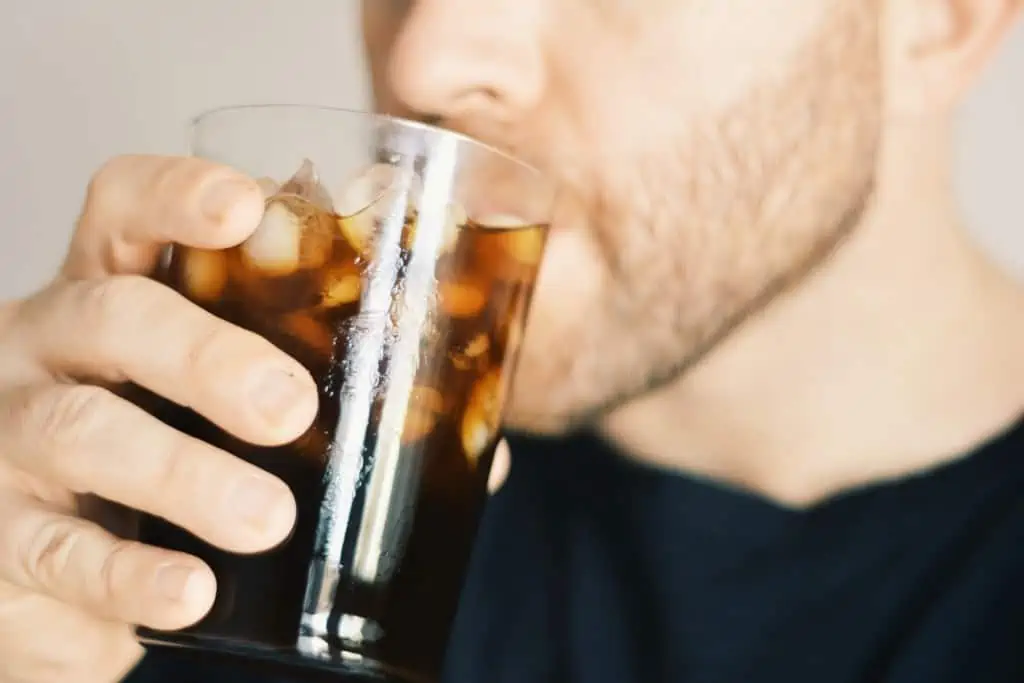
Enjoying ready-to-drink black coffee over ice …
So, why did we dip into this category again in 2020, despite a lack of overall enthusiasm about the genre? Well, even a casual peruser of supermarket shelves can witness the growth of the cold brew segment, and might even recognize the increase in single-origin coffee names. The trend is obviously much more than a passing fancy — RTD black coffee is here to stay. And based on the overall quality of the 37 RTDs we tested this month, this is a welcome development.
Better Green Coffee, Better RTD
Of the 37 samples we tested for this month’s report — all unadulterated cold black coffees with no additives (save nitrogen gas in a few cases), we identified 11 samples that rated 92-94, seven of which are single-origin coffees. And the four blends included here are consciously crafted, thoughtful compositions of green coffees of distinctive character. In fact, two of these four blends are coffees we have tested on earlier occasions by cupping for brewed applications or as espresso.
You probably know where this is headed: It’s clear that the greater the care and attention put into sourcing the green coffee, the more likely it is that a roaster has a decent shot at crafting a successful RTD cold coffee. We found no muted flavors or flat acidity with these 11 top-rated coffees. They are the equal of their hot-brewed equivalents in nuance, depth, elegance and complexity.
Let’s take a look at what makes a good RTD cold coffee. We spoke with most of the submitters of the 11 top-scoring coffees we review here, asking them about their specific choices and processes as well as their thoughts on RTDs’ position in the specialty coffee industry more generally.
Our Testing Protocol
Instead of testing these RTDs over ice, which we’ve done in previous years, we simply chilled all the samples to refrigerator temperature, roughly 36 degrees Fahrenheit. This eliminates the risk of inadvertently diluting the coffees. We evaluated each coffee in four of our usual categories: Structure/Acidity, Body, Flavor and Aftertaste, but dropped Aroma, adding in its place a With Milk category. (Our ratio of coffee to cold whole milk was 5:1.)
The Top-Scorers
Scores for the 37 samples ranged from 76-94. Despite the wide range (one sample scored below 80 points, the cutoff for specialty coffee, because of an obvious mold defect), a full 20 coffees, i.e., more than half, scored 90 or above, and nine more scored 86 or higher.
Of the 11 coffees we review here, nine were cold-brewed, meaning they are made by steeping ground coffee for long periods in cold or room-temperature water. Beyond this basic methodology, the roasters we talked with reported many variations in the details of their procedures, from water temperature to length of brew time to brew vessel. Needless to say, we didn’t find the overall tendency to muted uniformity suggested by our previous two RTD reports. Rather, we found range, depth, multi-faceted profiles, and nuanced sensory experiences from traditional to innovative — in short, we found cold coffee experiences every bit as impressive as we might find among a range of whole-bean coffees designed for hot brewing.
Seven of the top-scoring 11 coffees, going from 93-94, are single-origin RTD cold coffees. The four at the top, which all scored 94, include two Ethiopias, a Kenya and a Brazil.
The Bonfire Ethiopia Nano Challa Cold Brew, which I found deliciously reminiscent of sipping a fine, naturally sweet but unsugared iced tea with lemon on a summer afternoon, was brewed at 36-40 degrees in the refrigerator for 24 hours using the full-immersion method and a 30-gallon Cold Brew Avenue brewer. Owner of Carbondale, Colorado-based Bonfire Charlie Chacos chose this coffee for its bright, citrusy character, and he sells it in 50-ounce pouches.
San Francisco-based Four Barrel Coffee sent us four single-origin samples that offered a broad range of compelling sensory pleasure. The Kenya Kamoini, in particular, grabbed us with its classic sweet-savory Kenya profile with notes of tart pie cherry and spice-toned freesia-like florals.
This is one of just two coffees reviewed here that is brewed hot, then flash-chilled in an oxygen-free environment before being moved into aesthetically pleasing little cans. Four Barrel co-owner Jodi Geren says this method allows “a proper extraction that showcases clarity and florality.” She adds that brewing hot “really lays bare the essence of a coffee, so it requires that we use our very best single origins — those coffees that are the cornerstones of our sourcing program in the first place.”
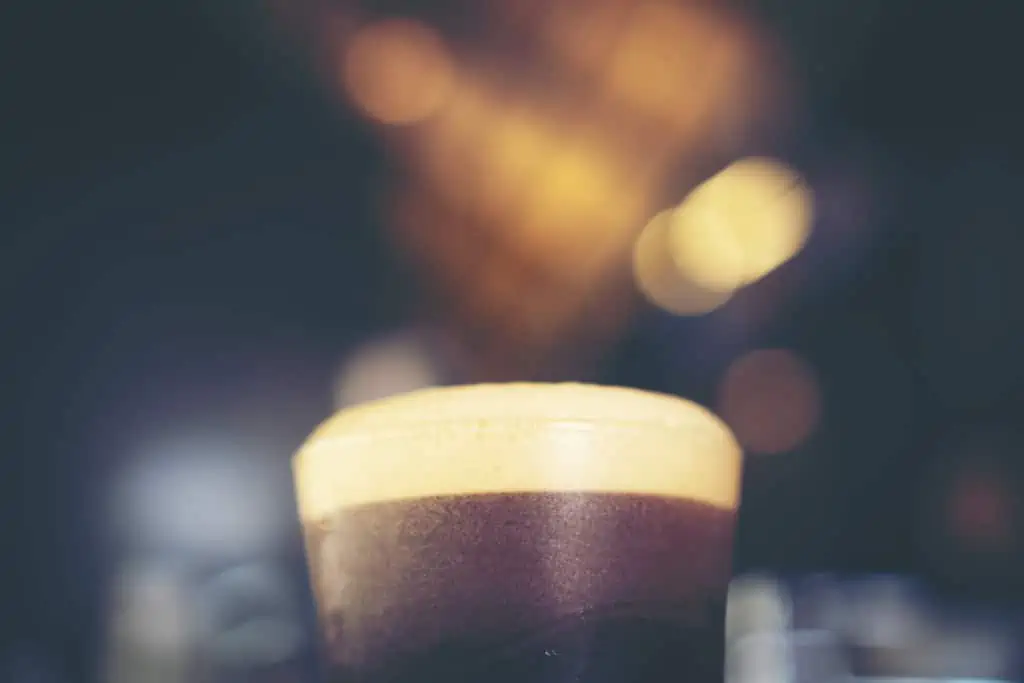
Freshly poured nitro cold brew
We got a sneak preview of Denver-based Corvus Coffee’s new cold brew lineup, which will debut later this month. The Guji Oraga Nitro Cold Brew, a natural-processed coffee brewed cold over 12 hours, shows deep notes of sweet peach and tart pomegranate, with an attractive, rum-barrel-like fermenty sweetness. Nitrogen gas is added at the end of the process to further vivify the body and create a head when pouring.
One stellar cold brew came all the way from Taiwan. GK Coffee, based in the small city of Yilan, chose an Ipanema Brazil for its cold brew base. Although it’s a washed-process coffee, because of experimental processing moves (see review), this Black Edition A-41 Red Cherry displays a subtle ferment-related note suggesting cherry liqueur. Owner Gary Liao brews this coffee for 4-5 hours in the refrigerator at a ratio of 1:15 before bottling. He says that, while cold brew is popular in Taiwan because summers are so hot, most people drink darker-roasted blends rather than light-roasted single-origins such as this one.
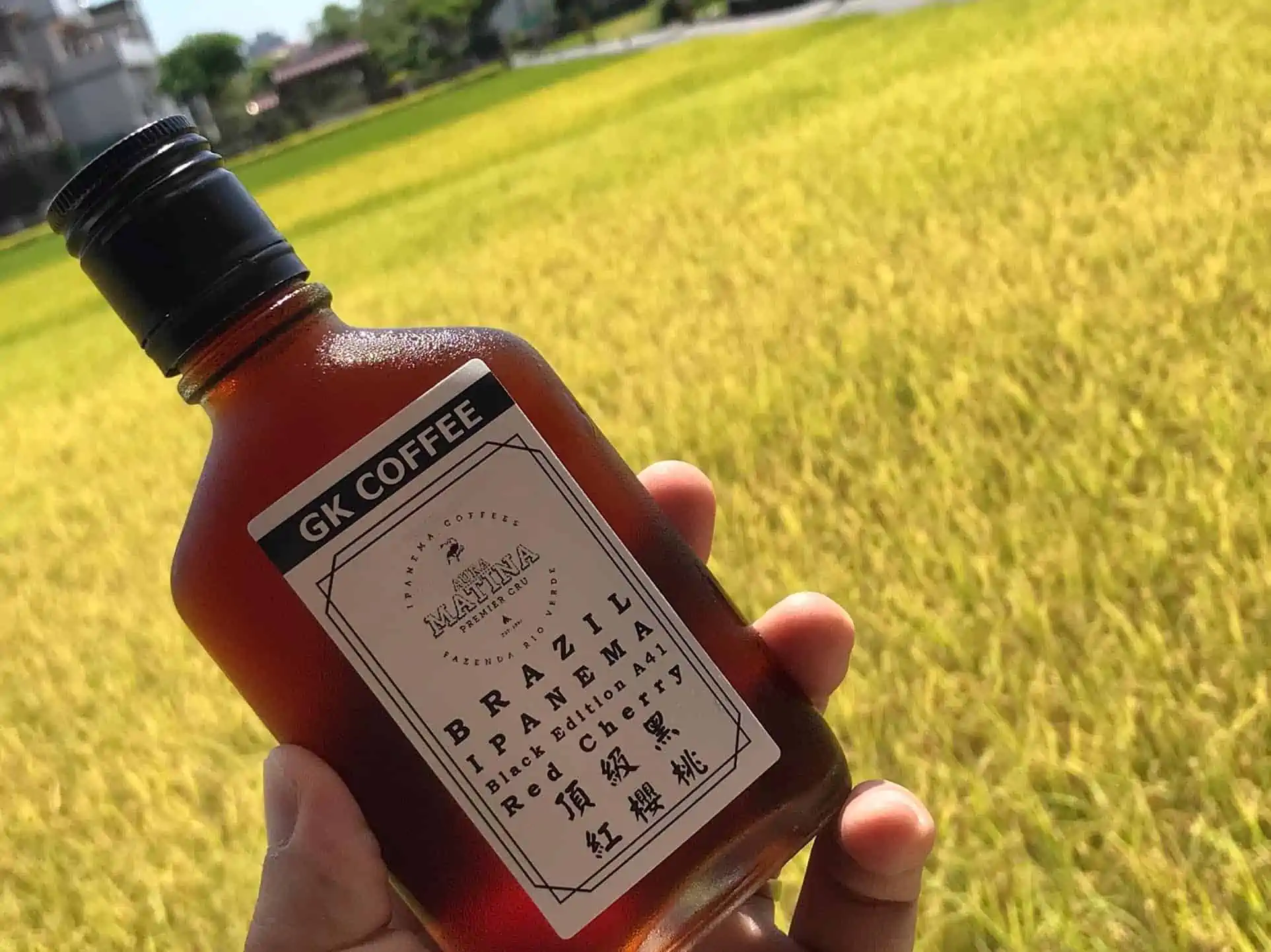
Brazil Ipanema Black Edition A41 Red Cherry ready-to-drink coffee by GK Coffee in Taiwan.
Three at 93
Another single-origin cold brew that impressed us is Collage Coffee’s Asfaw Maru Ethiopia Natural. The Grove City-based roastery and art gallery bottles its cold brew in pretty glass jars. Owner Joe Funte describes the process: “We use a Yama cold drip tower, brewing the coffee (with a Chemex grind) for approximately 11 hours at a 1:13 ration of coffee to water.” The end result is a lovely winy, cocoa-toned and floral RTD.
Yet another single-origin Ethiopia, Klatch Coffee’s Washed Guji Anasora Cold Brew came in at 93. Roaster Jenn Hwang finds that “using the BrewBomb drip method keeps a constant flow for consistent results and enhances the flavor, and we flush with nitrogen for freshness.” Of this particular coffee, she says, “We chose this Ethiopian Washed Guji Anasora because it reminded us of the Ethiopia Gedeb that won America’s Best Cold Brew a few years back. When we cupped and bought this Ethiopia, we knew we had to try it as a cold brew. We really love it both hot and cold!”
Klatch’s CEO, Heather Perry, adds, “Cold brew and RTD are here to stay. I think what we are seeing now is the second evolution of RTD coffee. I think of drinks like Starbucks’ frapp as the first version. Then, you have cold brew and nitro as the second evolution. And while these are nice, they are like when everyone was drinking light-roasted bland coffee and then came Peet’s and Starbucks with their dark-roasted and it tasted so different and people loved it. Now, we are entering the third evolution. We want more than just chocolate out of our coffee — we want those same delicious flavors that are in our hot Kenyas and Ethiopias. What we previously had to experience by doing a hot brew over ice, or something like that, is now ready to enjoy out of a tap or in a bottle. I imagine someone will be introducing a Geisha (if you didn’t already test one in this sampling). And I think Geisha would be delicious and refreshing in this format, like drinking a tropical tea. Many people like to add cream and sweetener to more traditional cold brew, but I think as we move to fruitier coffees we actually open up the product to an entirely new consumer.”
States Coffee Cold Brew is one of the four top-ranking blends featured here. States is based in the small northern California town of Martinez. One of owner/roaster Keith Gehrke’s cold brews appeared in our 2018 report as well. This year, his entry is a blend of Colombia and Guatemala coffees that harmonize around attractive bittersweet flavors like dark chocolate and candied tangerine.
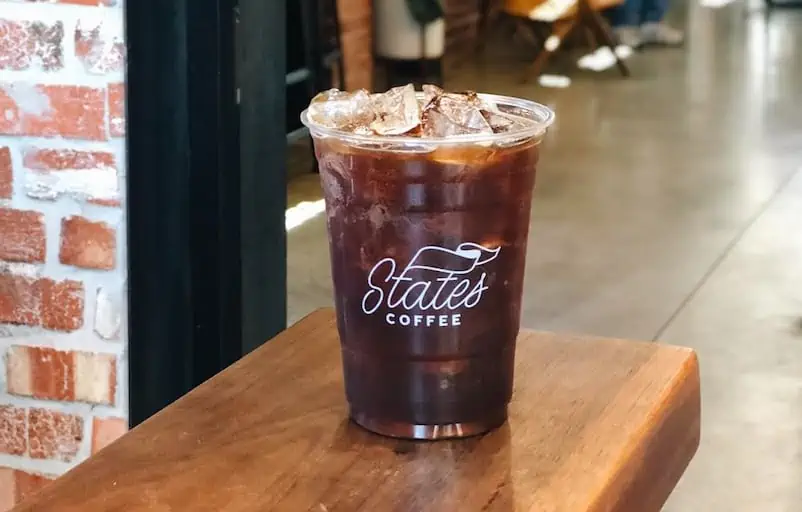
States Coffee ready-to-drink coffee on ice. Photo courtesy of States Coffee & Mercantile.
Of this coffee Gehrke says, “We use five-gallon stainless steel brewing buckets with toddy paper and mesh filters. We steep overnight using warm water and a drip grind. Others use cold water and a coarse grind but, after multiple tests, we found that our coffee and ratio taste better with warm water and a finer grind. The coffee is the same blend we use for all of our in-house espresso drinks. We make sure that the coffee has one week of age on it before we brew it for cold brew. Coffee that’s too fresh was not yielding the best tasting brew, either. It’s been a fun labor of love experimenting with the process and dialing in the process.”
And Two More at 93
Perhaps the most recognizable name on this list is Stumptown Coffee Roasters, the Portland, Oregon-based company that was a cornerstone of the third-wave coffee scene when it sold to investment firm TSG Partners in 2011; JAB Holdings now owns a majority stake. Nonetheless, Stumptown’s excellent coffee program skips merrily along, only at larger scale. Stumptown sells a number of cold-brewed RTDs. Its Ethiopia Guji impressed us with its lively acidity juxtaposed with deep notes of dark caramel and vanilla bean.
Head brewer Brent Wolczynski describes Stumptown’s process: “We brew the Guji with filtered and UV-treated cold water for 16 hours. It is then filtered through a stainless screen, and then filtered once again through a paper filter to polish it off for a really clean and refreshing cup. We use nitrogen all throughout the process to make sure it is not in contact with oxygen at any time, but [the nitrogen] is not dissolved into the solution for a creamy mouthfeel [as in] our Nitro Cold Brew. We want our Guji cold brew to be light, tea-like, fruit-forward, and refreshing. Dissolving nitrogen into solution adds creaminess and a heavy mouthfeel that would take it in a different direction.”
Rounding out the 93-scoring RTDs is Tulsa, Oklahoma-based Topéca Coffee’s Crushable Nitro Cold Brew, whose 8.4-ounce cans pack the punch of a 20-ounce cup of coffee due to a very high coffee-to-water ratio. The coffee is Topéca’s tried and true Porch Session, a blend of a natural-processed coffee from a farm the brand co-owns in El Salvador, Finca El Manzano, and a pulped natural Brazil Fazenda Santana. Head of Cold Brew Tyler Duncan says, “We hit 250 pounds of our Porch Session Blend with about 150 gallons of hot water, then make sure the slurry is all wetted. Once we’re sure it’s good to go, we hit it with room-temperature water to crash the temperature. We pass the coffee through a filter train to make sure it’s super clean and then can it from our brite tank. We dose liquid nitrogen into each can so that it holds pressure and gives it a velvety texture. Then, voila! Crushable Nitro Cold Brew.”
About cold brews’ staying power and the shift toward single-origin coffees in this segment, Duncan says, “I think the trend is definitely here to stay. The demographic that used to consume the most coffee has shifted; now the millennial generation purchases more, and their purchasing habits are different from the generation before them. With the globalization of information, more people have more access to the injustices that have long gone unchecked in coffee history, and coffee’s history is replete with colonization and slave labor. People can see more of what happens in the supply chain and generally care more about what happens in the supply chain. At the very least, people want to feel good about their purchases. Single-origins are a way to feel better about purchasing — they have more traceability.”
Two Solid Blends at 92
Rounding out the top 11 RTDs are two blends: Equator Coffee’s Cold Coffee, not a cold brew but a coffee that has been brewed hot and then flash-chilled, and Charlotte, North Carolina-based Magnolia Coffee Roasters’ Jade Espresso Blend Nitro Cold Brew.
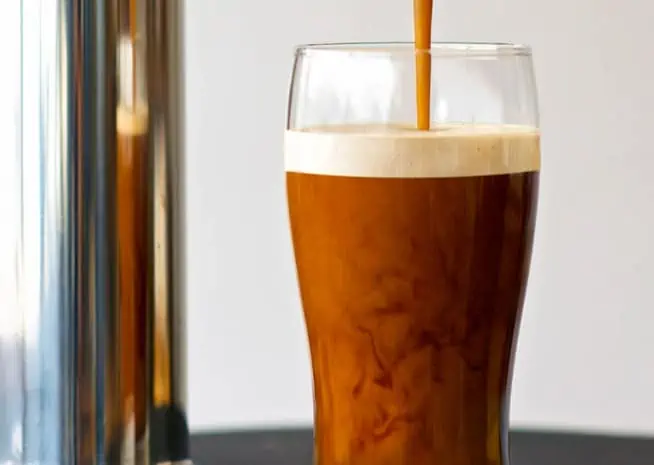
Jade Espresso nitro cold brew on tap at Magnolia Coffee. Photo courtesy of Magnolia Coffee.
The Magnolia RTD blend is based on Magnolia’s bestselling espresso blend, which owner Jay Gestwicki says combines a pre-roast blend of a semi-washed Brazil, a washed Uganda and Colombia, and an El Salvador natural, with a natural Ethiopia Yirgacheffe added post-roast.
The Equator Blend is the Bay Area brand’s most popular coffee, combining a low-toned Lintong Sumatra Lintong and brighter Kenya and Colombia coffees. Director of Coffee Ted Stachura says, “It is designed to be a crowd-pleaser, roasted just dark enough to satisfy those who prefer dark chocolate-like flavors in coffee, while retaining enough sweetness and complexity for those who like a lighter-roasted touch.”
Stachura agrees that RTD is more than just a trend: “We have seen a gradual movement away from very sweet and milky versions of canned and bottled coffees that emerged over a decade ago and are now seeing a great deal of product diversity (alternative milk options, flavorings, carbonation, etc.) with new players constantly entering the market. Distribution continues to be the major hurdle for smaller roasting companies since refrigerated vehicles are often required and shelf space in grocery stores is highly competitive. Specialty coffee roasters love seeing microlots and other single-origin offerings in RTD format, but it adds complication and cost to the production and distribution process. Since many roasters have educated consumers that look for information on coffee labels about farm and producer, that same level of detail is now expected on RTD cans. As more exclusive coffees are made available in RTD format, we will see what the market is willing to bear.”
There’s no doubt he’s right. We will certainly stick around to see what’s next in the rapidly evolving realm of RTD cold black coffee.










